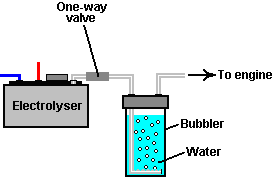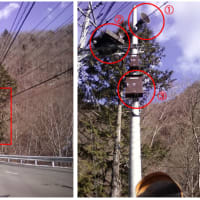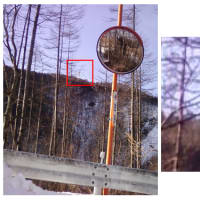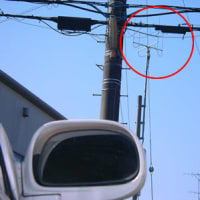When
the transistor switches off, the coils try to pull the transistor Drain
connection down to a voltage well below the 0-volt battery line. To
prevent this, a 1N4007 diode is connected across the cell and its
coils. The diode is connected so that no current flows through it until
the transistor Drain gets dragged down below the 0-volt line, but then
that happens, the diode effectively gets turned over and as soon as 0.7
volts is placed across it, it starts to conduct heavily and collapses
the negative voltage swing, protecting the transistor, and importantly,
keeping the pulsed waveform restricted to positive DC pulses, which is
essential for tapping this extra environmental energy which is what
actually performs the electrolysis. You can easily tell that it is the
environmental “cold” electricity which is doing the electrolysis as the
cell stays cold even though it is putting out large volumes of gas. If
the electrolysis were being done by conventional electricity, the cell
temperature would rise during the electrolysis. A John Bedini pulser
circuit can be used very effectively with a cell of this type and it
adjusts automatically to the resonant frequency as the cell is part of
the frequency-determining circuit.
トランジスタのスイッチが
OFFのとき、コイルは、トランジスタのドレン(d)接続を抜き取り、バッテリー線の電圧を0Vまで下げようとします。これを防止するために、セルおよび
そのコイルを横切って1N4007ダイオードが接続されます。ダイオードが接続されて
0ボルトラインに引きずられるので、電流はトランジスタのドレン(d)まで全く流れません、しかし、ダイオードは順方向電圧が0.7Vに達しないと電流が
ながれません。スタート時の動作は重く、負の電圧振幅を潰しトランジスタを保護します。そして重要なのは、直流パルス化された波形を(+)に限定されるよ
うにしておくこと、それらは、電解を実行するのに追加されるであろう周囲のエネルギーを利用するのに不可欠なものです。電解セルが電気分解をして大量の水
素混合ガスを放出しても、冷たいまま(発熱しない)なので、あなたは、環境に配慮した「冷たい」電気であると簡単に言うことができます。もしも、従来通り
の電気分解が行われるなら、セル温度は電気分解の間、上昇することでしょう。ジョンBedini氏のパルス回路は、このタイプのセルを使用することで非常
に効果的に使用されます、そして、セルが周波数決定する回路の一部であるので、それは自動的に共振周波数に調整されます。
The
BUZ350 MOSFET has a current rating of 22 amps so it will run cool in
this application. However, it is worth mounting it on an aluminium
plate which will act as both the mounting and a heat sink but it should
be realised that this circuit is a bench-testing circuit with a maximum
current output of about 2 amps and it is not a Pulse-Width Modulation
circuit for a high-current DC electrolyser. The current draw in this
arrangement is particularly interesting. With just one tube in place,
the current draw is about one amp. When a second tube is added, the
current increases by less than half an amp. When the third is added,
the total current is under two amps. The fourth and fifth tubes add
about 100 milliamps each and the sixth tube causes almost no increase
in current at all. This suggests that the efficiency could be raised
further by adding a large number of additional tubes, but this is
actually not the case as the cell arrangement is important. Stan Meyer
ran his VolksWagen car for four years on the output from four of these
cells with 16-inch (400 mm) electrodes, and Stan would have made a
single larger cell had that been feasible.
BUZ350
MOSFET [電界効果トランジスタ(FET)の一種、パワーMOSFET(英:Power
MOSFET)、大電力を取り扱うように設計されたMOSFETのこと。
他のパワーデバイスと比較するとスイッチング速度が速く、低電圧領域での変換効率が高い為、200V以下の領域で、スイッチング電源や、DC-DCコン
バータ等に用いられる。]
は、22Aの定格電流なので、動作中は涼しく動くでしょう。しかし、それを実装するとき、アルミニウムプレート上に設置することや、同様にアルミのヒート
シンクをつけることは価値があります。しかし、この回路が約2Aの最大電流出力ベンチテスト回路であり、大電流(直流)で電気分解をするための、
PWM(パルス幅変調回路)でないことを理解するべきです。そして、次に書く電流の流れ方は、特に興味深いものです。1つのチューブがある時は、電流は約
1Aです。2番目のチューブが追加されると、電流は0.5A以下で増加します。3番目のチューブが追加されると、全体の電流は2A弱になります。4番目と
5番目のチューブが追加されると、それぞれ約100mAで増大します。そして、6番目のチューブは、追加されても電流はほとんど増加しません。これは、
チューブを多数追加することによって、効率がさらに良くなる可能性を示
していますが、事例として、チューブの配置の方が重要(分解効率に影響する)なので、本数はそれほど重要ではありません。スタンマイヤー氏は、4本の電極
チューブ、長さ16インチ(400mm)の(水素混合ガス)アウトプットにおいて、彼のフォルクスワーゲンを4年間走らせました。そして、本数や配置が重
要でなければ、スタン氏は単一のより大きいセルを作ったことでしょう。
Although
the current is not particularly high, a five or six amp
circuit-breaker, or fuse, should be placed between the power supply and
the circuit, to protect against accidental short-circuits. If a unit
like this is to be mounted in a vehicle, then it is essential
that the power supply is arranged so that the electrolyser is
disconnected if the engine is switched off. Passing the electrical
power through a relay which is powered via the ignition switch is a
good solution for this. It is also vital that at
least one bubbler is placed between the electrolyser and the engine, to
give some protection if the gas should get ignited by an engine
malfunction.
電流は特に高くはありませんが、5Aまたは6Aの回路ブレーカーまたは
ヒューズは、偶然のショートに対して保護を目的に、電源と回路の間に配置する必要があります。もしこのような電解槽を乗り物に設置する場合は、エンジンを
停止した時に電解槽の接続も切れるように配線されることが必要です。イグニション・スイッチを通して動かされるリレーに配線を通すのが、良い解決策です。
また、少なくとも1個のbubbler(上の図)が電解槽とエンジンの間に置かれることも、安全上重要であり、エンジンの点火によって起こるガス引火
(バックファイア)から、電解槽を保護するためにも必要です。
感想:
回路の説明は、理解できた範囲でのフィーリング意訳。
解釈が逆になっている場合も考えられますので、怪しい部分は原文で確認してください。
わかったことは、スタンマイヤー氏のセルから発生するガスも、ブラウンガスとおなじ原子水素ガスだったようです。
ブラウンガスは、溶接機ですでに実用化されているので、ここで書かれている内容についても信憑性が相当高くなったと思います。
そう考えると、スタンマイヤー氏の自動車(エンジン)は、爆縮で動かしていたように思えます。
ブラウンガスが、どのようなセルで分解しているのかわかりませんが、分解装置は実在しているのでこのセルも分解できる可能性が、非常に高いと言える。(と言うかできると思います)
国も違い、考え方も違った2人が共に辿り付いた結論が、原子水素ガスとは・・・ 興味深いです。
次回は、回路に使用される構成部品についてです。
Pulsed Water-splitters No.4(パルスを用いた水の分解)
http://ameblo.jp/ghostripon/entry-10333372780.html
■過去の記事
Pulsed Water-splitters No.1(パルスを用いた水の分解)
http://ameblo.jp/ghostripon/entry-10330994478.html
Pulsed Water-splitters No.2(パルスを用いた水の分解)
http://ameblo.jp/ghostripon/entry-10331992718.html
■関連記事
Stanley Meyer Data特許資料(英文) [pdf 221ページ]
http://www.free-energy-info.co.uk/MeyerData.pdf
Stanley Meyer - It Runs On Water(水で走る自動車)
http://ameblo.jp/ghostripon/entry-10328859717.html
【資料】Stanley Meyer - It Runs On Water(水で走る自動車)
http://ameblo.jp/ghostripon/entry-10330431267.html
原子水素ガス - HHO GAS - ブラウン・ガス -
http://ameblo.jp/ghostripon/entry-10323958738.html
【続】原子水素ガス - HHO GAS - ブラウン・ガス -
http://ameblo.jp/ghostripon/entry-10328872198.html
燃える塩水 - Salt Water -
http://ameblo.jp/ghostripon/entry-10323134471.html
Byron New Energy - チャージ水 - charged water -
http://ameblo.jp/ghostripon/entry-10324533613.html
【転載終了】




















